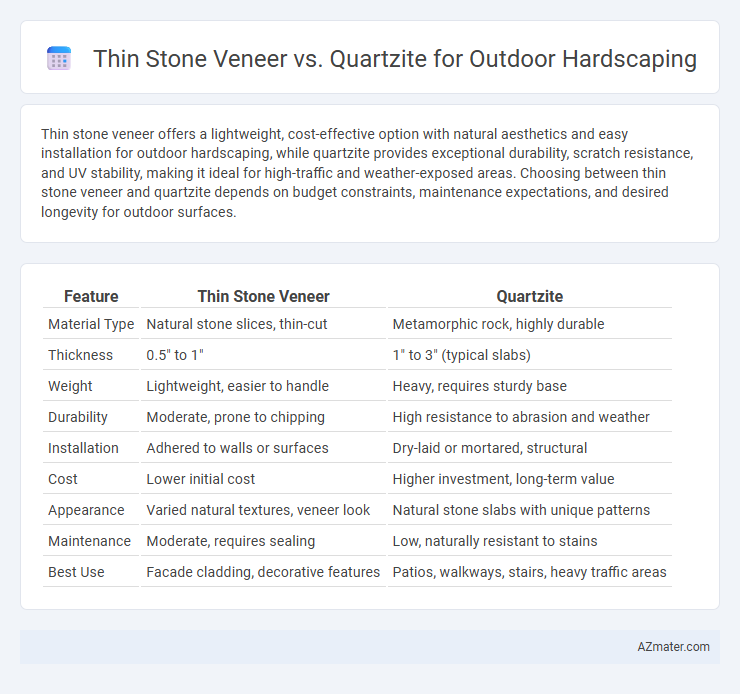Thin stone veneer offers a lightweight, cost-effective option with natural aesthetics and easy installation for outdoor hardscaping, while quartzite provides exceptional durability, scratch resistance, and UV stability, making it ideal for high-traffic and weather-exposed areas. Choosing between thin stone veneer and quartzite depends on budget constraints, maintenance expectations, and desired longevity for outdoor surfaces.
Table of Comparison
| Feature | Thin Stone Veneer | Quartzite |
|---|---|---|
| Material Type | Natural stone slices, thin-cut | Metamorphic rock, highly durable |
| Thickness | 0.5" to 1" | 1" to 3" (typical slabs) |
| Weight | Lightweight, easier to handle | Heavy, requires sturdy base |
| Durability | Moderate, prone to chipping | High resistance to abrasion and weather |
| Installation | Adhered to walls or surfaces | Dry-laid or mortared, structural |
| Cost | Lower initial cost | Higher investment, long-term value |
| Appearance | Varied natural textures, veneer look | Natural stone slabs with unique patterns |
| Maintenance | Moderate, requires sealing | Low, naturally resistant to stains |
| Best Use | Facade cladding, decorative features | Patios, walkways, stairs, heavy traffic areas |
Overview of Thin Stone Veneer and Quartzite
Thin stone veneer offers a lightweight, cost-effective solution for outdoor hardscaping, replicating the natural look of full stone with easier installation and lower material costs. Quartzite, a durable and dense natural stone, provides exceptional resistance to weathering and abrasion, making it ideal for high-traffic outdoor areas. Both materials enhance aesthetic appeal and structural integrity, with thin stone veneer prioritizing versatility and quartzite excelling in longevity and strength.
Key Material Differences
Thin stone veneer offers a lightweight, versatile option made from natural stone slices, ideal for easy installation on various outdoor surfaces, while quartzite provides a durable, high-density metamorphic rock with exceptional hardness and resistance to weathering. Quartzite's natural formation under heat and pressure makes it significantly more resistant to scratching and erosion compared to the typically softer materials used in thin stone veneers. For outdoor hardscaping, quartzite ensures long-lasting structural integrity and minimal maintenance, whereas thin stone veneer emphasizes aesthetic flexibility and cost-effectiveness.
Durability and Weather Resistance
Thin stone veneer offers moderate durability and weather resistance, making it suitable for decorative outdoor hardscaping but may require sealing and maintenance to prevent damage from freeze-thaw cycles and moisture infiltration. Quartzite is an exceptionally durable natural stone with high resistance to weathering, abrasion, and temperature fluctuations, making it ideal for outdoor hardscaping applications exposed to harsh environmental conditions. Its dense, non-porous structure ensures long-lasting performance with minimal upkeep, outperforming most thin stone veneers in outdoor durability and weather resistance.
Installation Process and Complexity
Thin stone veneer offers a lightweight and flexible installation process, making it ideal for DIY outdoor hardscaping projects with minimal structural support requirements. Quartzite, being a dense and heavy natural stone, demands professional expertise, specialized tools, and precise handling during installation to ensure durability and proper adhesion. The complexity of working with quartzite increases labor time and costs compared to the relatively straightforward and quicker application of thin stone veneer.
Aesthetic Options and Design Flexibility
Thin stone veneer offers a wide range of aesthetic options, including various colors, textures, and patterns that mimic natural stone, providing extensive design flexibility for customized outdoor hardscaping. Quartzite features a unique natural crystalline structure with shimmering layers and rich earthy tones, adding elegance and durability while allowing creative variation in layout and finish. Both materials support versatile applications, but quartzite's strength and distinctive appearance make it ideal for high-traffic areas and striking architectural accents.
Maintenance Requirements
Thin stone veneer offers low maintenance with easy cleaning and minimal sealing needed, making it resistant to weathering and stains in outdoor hardscaping applications. Quartzite, a natural metamorphic rock, requires occasional sealing to prevent moisture penetration and maintain its durability but is highly resistant to scratches and fading. Both materials withstand outdoor conditions well, but quartzite's dense composition offers superior long-term resilience with periodic care.
Cost Comparison
Thin stone veneer offers a cost-effective solution for outdoor hardscaping, typically priced between $6 and $12 per square foot, including installation, making it a budget-friendly option for enhancing patios and retaining walls. Quartzite, known for its durability and aesthetic appeal, generally costs significantly more, ranging from $15 to $30 per square foot installed, due to its natural hardness and limited quarry sources. When balancing initial investment with long-term value, thin stone veneer provides an affordable choice without sacrificing visual impact, whereas quartzite demands a higher upfront expense for superior resilience and weather resistance.
Environmental Impact
Thin stone veneer offers a lower environmental footprint due to its reduced material extraction and lighter transportation weight compared to quarried quartzite slabs. Quartzite, while durable and naturally resistant to weathering, involves more intensive mining and higher energy consumption in production and shipping. Selecting thin stone veneer minimizes land disruption and carbon emissions, making it a more sustainable choice for eco-conscious outdoor hardscaping projects.
Suitability for Different Outdoor Applications
Thin stone veneer offers a lightweight, versatile option ideal for vertical surfaces like walls and fireplaces in outdoor hardscaping, providing natural aesthetics without the weight of full stone. Quartzite, renowned for its exceptional hardness and weather resistance, excels in high-traffic areas like patios, walkways, and driveways, ensuring long-lasting durability under varying climate conditions. Selecting between thin stone veneer and quartzite depends on the structural requirements and desired application, with quartzite favored for heavy-duty ground surfaces and thin veneer preferred for decorative vertical enhancements.
Pros and Cons Summary
Thin stone veneer offers a lightweight, cost-effective option for outdoor hardscaping with easy installation and a wide variety of styles, but it may lack the natural durability and impact resistance of quartzite. Quartzite provides exceptional hardness, weather resistance, and longevity ideal for high-traffic outdoor areas, though it is heavier, more expensive, and requires professional installation. Choosing between the two depends on budget constraints, desired aesthetics, and the specific demands of the outdoor environment.

Infographic: Thin stone veneer vs Quartzite for Outdoor hardscaping
 azmater.com
azmater.com